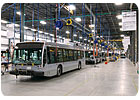
The $25 million, 140,000-square-foot facility began assembling buses in June 2009, just 14 months after construction began in April 2008. Since then, the plant has been humming. It has already produced orders for the Disney Co. and the Winter Olympics in Vancouver, BC. It’s now working on a 90-vehicle order from the New York City Transit system.
“It’s been quite an exciting and energizing startup,” says Jim Tooley, plant manager.
A subsidiary of Volvo Bus Corp., Nova Bus already had two production facilities in Quebec, Canada-in St. Francois-du-Lac and St. Eustache. However, if the company was going to pursue the U.S. public transportation market, it needed a U.S. facility. “Any public transportation contracts that rely on federal money must comply with the Buy America Act, which requires final assembly to take place in the United States,” explains Tooley.
Located just across the Canadian border, Plattsburgh was an ideal site for Nova’s U.S. plant, which employs 172. “The community was very welcoming,” Tooley recalls. “I constantly received calls from people asking how they could help.”
The facility produces 40-foot standard buses and 60-foot articulated buses. Either model can be equipped with diesel engines or hybrid-electric power trains. Two buses roll off the line each day.
The stainless steel bus frames are made at the company’s facility in St. Francois-du-Lac and shipped by truck to Plattsburgh. “We do all the rest, including installation of the engine, transmission, axles, tires, electrical components, windows and seats,” says Tooley. “When it reaches the end of the assembly line, it’s ready for delivery and commissioning.”
The assembly line consists of 17 stations. Each station is manned by four to six assemblers. A bus remains at a station for four hours. At some stations, subassemblies are installed underneath the bus at the same time that components are installed in the interior. Fasteners are installed manually with pneumatic, electric and hand tools. Adhesives and sealants are applied with handheld dispensing equipment. Every component is tested after assembly to ensure that it’s working correctly.
“Because these are very complex vehicles, troubleshooting a problem can be very challenging,” says Tooley.
A scoreboard on the shop floor displays how well the plant is performing on five key metrics: quality, delivery, cost, safety and morale.
Prior to joining the line, assemblers went through a two-week training and orientation program that was developed in conjunction with a local community college. The program consisted of eight days of classroom work and two days of hands-on training at the plant. The classroom sessions covered Nova’s corporate values and manufacturing philosophies, health and safety issues, and how to read blueprints and bills of material. The latter element was particularly important, since each customer tends to equip its buses differently. On the line, assemblers learned how to apply adhesives and tighten threaded fasteners.
Editor’s note: “Moving Forward” is a regular series profiling new or expanding assembly plants. If you know a facility that’s opening, growing or investing in new equipment, we’d like to hear about it. Send an e-mail to John Sprovieri, editor of ASSEMBLY, at sprovierij@bnpmedia.com, or call 630-694-4012.